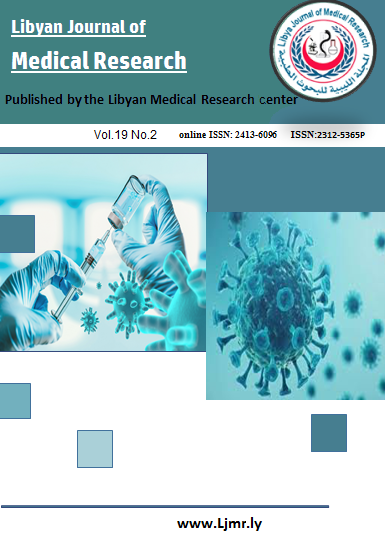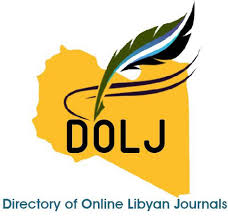Clinical Spectrum and Outcomes of Non-Traumatic Acute Abdominal Pain in Hospitalized Children: A Retrospective Descriptive Study
DOI:
https://doi.org/10.54361/LJMR.19.2.22Keywords:
pediatric abdominal pain, appendicitis, urinary tract infection, acute gastroenteritis, ultrasound, diagnosis, hospital stayAbstract
Background: Acute abdominal pain is a frequent presentation in pediatric emergency departments, encompassing a broad range of etiologies from benign to life-threatening conditions. Distinguishing between surgical and non-surgical causes remains a clinical challenge. Objective: To analyze the clinical spectrum, diagnostic categories, and hospital outcomes of children admitted with non-traumatic acute abdominal pain. Material and Methods: A retrospective study was conducted on (84) pediatric patients admitted with acute abdominal pain. Data collected on demographics, clinical features, final diagnoses, management approaches, and hospital stay duration were analyzed. Statistical tests were applied to compare clinical features between surgical and medical cases. Results: The most common diagnoses were urinary tract infection (35.7%) and acute gastroenteritis (25%). Appendicitis was diagnosed in (9.5%) of cases, all requiring surgical intervention. No significant association was found between clinical symptoms and surgical need. Hospital stay duration did not differ significantly among diagnostic groups. Conclusion: This study confirms that most pediatric admissions for non-traumatic acute abdominal pain are due to medical causes, with UTI and AGE being predominant. Appendicitis was the most common surgical condition. Symptom overlap made clinical differentiation difficult. Ultrasound and labs were essential for diagnosis. Our findings support recent literature on conservative management trends and the importance of imaging.
Downloads
References
1. H.-P. Wu and W. C. Yang, “Etiology of non-traumatic acute abdomen in pediatric emergency departments,” World Journal of Clinical Cases, vol. 1, no. 9, p. 10, 2013.
2. Erkan T, Cam H, Ozkan HC, Kiray E, Erginoz E, Kutlu T, et al. Clinical spectrum of acute abdominal pain in Turkish pediatric patients: a prospective study. Pediatr Int 2004; 46: 325-9.
3. Yang WC, Chen CY, Wu HP. Etiology of non-traumatic acute abdomen in pediatric emergency departments. World J Clin Cases 2013; 1(9): 276-84.
4. Andersson RE, Hugander A, Ravn H, Offenbartl K, Ghazi SH, Nyström PO, Olaison G. Repeated clinical and laboratory examinations in patients with an equivocal diagnosis of appendicitis. World J Surg 2000; 24: 479-485.
5. Beck NA et al. Abdominal pain in children. Pediatr Clin North Am. 2017; 64 (3): 549-565.
6. Roberts KB. Revised AAP guidelines on the diagnosis and management of initial UTI in febrile infants and young children. Pediatrics. 2019; 143(3):e20182679.
7. Elliott EJ. Acute gastroenteritis in children. BMJ. 2007; 334(7583):35-40.
8. Alvarez L, Garcia-Rodriguez J, Martin F, et al. Sonographic features and differentiation of mesenteric lymphadenitis in children. J Ultrasound Med. 2017; 36(12):2497–2503.
9. artelli M, Baiocchi GL, Di Saverio S, et al. 2023 WSES guidelines for diagnosis and treatment of acute appendicitis. World J Emerg Surg. 2023; 18(1):25.
10. Weiss PF, Feinstein JA, Luan X, Burnham JM, Feudtner C. Effects of medications, health status, and patient characteristics on treatment of children with Henoch–Schönlein purpura. Pediatrics. 2012; 129(5):e1160-e1167.
11. Di Nardo G, Aloi M, Ferrara A, et al. The role of intestinal ultrasound in the diagnosis of acute and chronic pediatric gastrointestinal disorders. Ital J Pediatr. 2015; 41:37.
12. aucier A. et al. Diagnostic challenges in pediatric abdominal pain. Acad Emerg Med. 2013; 20(5):469-475.
13. Benabbas R, Hanna M, Shah J, Sinert R. Diagnostic accuracy of point-of-care ultrasound (POCUS) for acute appendicitis in children: A systematic review and meta-analysis. Am J Emerg Med. 2021; 44:325–332.
14. Svensson JF, Patkova B, Almström M, et al. Nonoperative treatment with antibiotics versus surgery for acute nonperforated appendicitis in children: A pilot randomized controlled trial. Ann Surg. 2015; 261(1):67–71.
15. Kim JY, Kim KW, Park SH, et al. Non-operative management of uncomplicated appendicitis in children: A systematic review and meta-analysis. J Pediatr Surg. 2021; 56(9):1715-1723.
16. Conlon TW, Nishisaki A, Singh Y, et al. Point-of-care ultrasound in pediatric emergency medicine: Evidence, applications, and future directions. Pediatr Emerg Care 2020; 36(6):323–330.
17. Mandeville K, Chien M, Willy M, et al. Acute abdominal pain in children. Curr Probl Pediatr Adolesc Health Care. 2016; 46(8):248-270.
Downloads
Published
Issue
Section
License
Copyright (c) 2025 Fathia Hameda Ben Saleh (Author)

This work is licensed under a Creative Commons Attribution-NonCommercial-NoDerivatives 4.0 International License.
Open Access Policy
Libyan journal of medical Research (LJMR).is an open journal, therefore there are no fees required for downloading any publication from the journal website by authors, readers, and institution.
The journal applies the license of CC BY (a Creative Commons Attribution 4.0 International license). This license allows authors to keep ownership f the copyright of their papers. But this license permits any user to download , print out, extract, reuse, archive, and distribute the article, so long as appropriate credit is given to the authors and the source of the work.
The license ensures that the article will be available as widely as possible and that the article can be included in any scientific archive.
Editorial Policy
The publication of an article in a peer reviewed journal is an essential model for Libyan journal of medical Research (LJMR). It is necessary to agree upon standards of expected ethical behavior for all parties involved in the act of publishing: the author, the journal editorial, the peer reviewer and the publisher.
Any manuscript or substantial parts of it, submitted to the journal must not be under consideration by any other journal. In general, the manuscript should not have already been published in any journal or other citable form, although it may have been deposited on a preprint server. Authors are required to ensure that no material submitted as part of a manuscript infringes existing copyrights, or the rights of a third party.
Authorship Policy
The manuscript authorship should be limited to those who have made a significant contribution and intellectual input to the research submitted to the journal, including design, performance, interpretation of the reported study, and writing the manuscript. All those who have made significant contributions should be listed as co-authors.
Others who have participated in certain substantive aspects of the manuscript but without intellectual input should only be recognized in the acknowledgements section of the manuscript. Also, one of the authors should be selected as the corresponding author to communicate with the journal and approve the final version of the manuscript for publication in the LJMR.
Peer-review Policy
- All the manuscripts submitted to LJMR will be subjected to the double-blinded peer-review process;
- The manuscript will be reviewed by two suitable experts in the respective subject area.
- Reports of all the reviewers will be considered while deciding on acceptance/revision or rejection of a manuscript.
- Editor-In-Chief will make the final decision, based on the reviewer’s comments.
- Editor-In-Chief can ask one or more advisory board members for their suggestions upon a manuscript, before making the final decision.
- Associate editor and review editors provide administrative support to maintain the integrity of the peer-review process.
- In case, authors challenge the editor’s negative decision with suitable arguments, the manuscript can be sent to one more reviewer and the final decision will be made based upon his recommendations.














